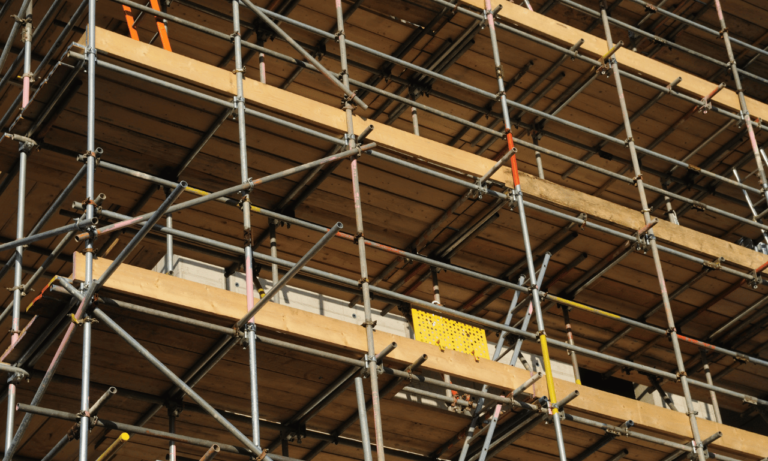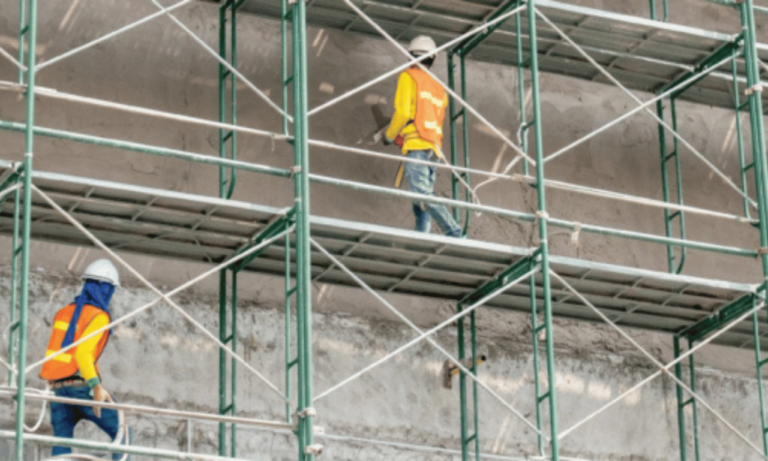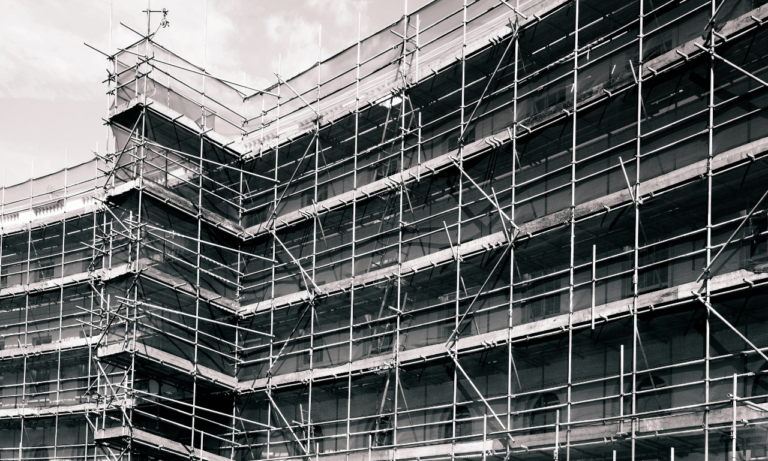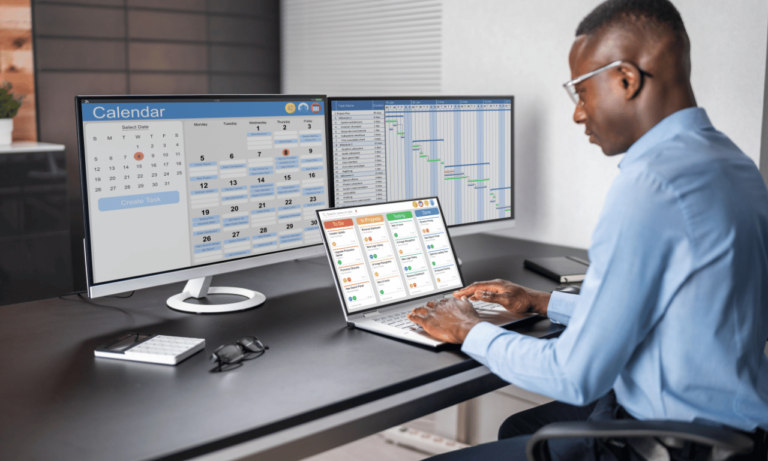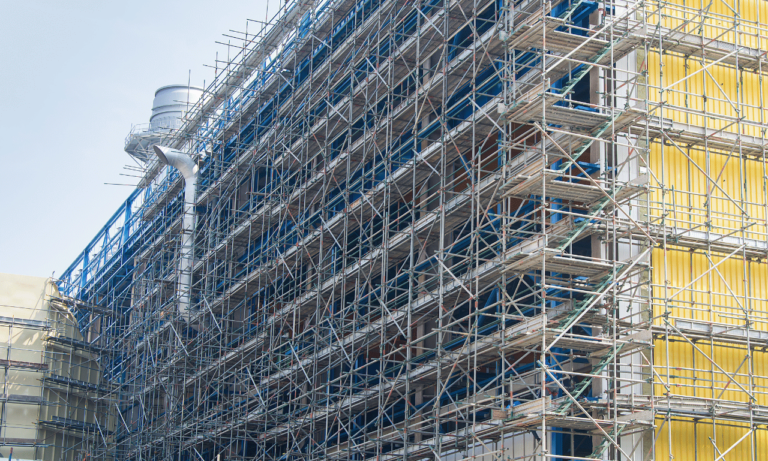Phone:
(+65)8319-0742
Setting up scaffolding is a critical step in construction projects, providing a stable and elevated platform for workers to safely access heights. This essential guide will walk you through the process of staging scaffolding, ensuring compliance with safety regulations and optimizing efficiency on the job site.
When it comes to construction equipment, access solutions are key, and scaffolding platforms play a vital role in providing a secure and reliable workspace. Industrial scaffolding systems have evolved with advanced technology to enhance safety and productivity on construction sites.
To begin, obtaining the necessary permits and approvals from local authorities is crucial. Complying with safety regulations ensures that your scaffold meets all standards. Safety should always be a top priority when setting up scaffolding, and regular inspection and maintenance are essential for its stability and longevity.
Key Takeaways:
- Staging scaffolding is essential for safe and efficient construction projects.
- Construction equipment like scaffolding platforms provide access solutions for working at heights.
- Obtaining permits and ensuring compliance with safety regulations is crucial.
- Proper assembly involves laying out the base, setting up vertical poles, adding diagonal braces, placing platforms, and attaching an access ladder.
- Safety guidelines, regular inspections, and maintenance are key for a stable and secure scaffold.
Types of Scaffolds for Different Projects
When it comes to construction projects, choosing the right type of scaffold is crucial. Different projects have varying requirements, and understanding the types of scaffolds available can help ensure the safety and efficiency of the work being done. In this section, we will explore three common types of scaffolds: frame scaffolds, suspended scaffolds, and cantilever scaffolds.
Frame Scaffolds
Frame scaffolds are one of the most widely used types of scaffolds in construction. They consist of a series of interconnected frames that are assembled to create a stable structure. The frames are made of durable materials like steel or aluminum, providing strength and stability. Frame scaffolds are versatile and can be easily customized to fit different project requirements. They are commonly used in building maintenance and new construction projects due to their stability and ease of assembly.
Suspended Scaffolds
Suspended scaffolds, as the name suggests, are suspended from the top of a building or structure. They are typically used for projects that involve working on vertical surfaces, such as painting or window cleaning. Suspended scaffolds are designed to provide a platform for workers to access elevated areas safely. They consist of a sturdy platform suspended by ropes or cables and can be adjusted to different heights. Suspended scaffolds offer flexibility and mobility, making them ideal for projects where horizontal access is limited.
Cantilever Scaffolds
Cantilever scaffolds are specifically designed for projects that involve working on stairways or sloped surfaces. They are constructed by extending the scaffold platform horizontally from a supported structure, such as a building or a bridge. Cantilever scaffolds provide workers with a stable platform to access elevated areas, even on uneven or inclined surfaces. This type of scaffold offers convenience and safety when working on projects that require access to hard-to-reach areas.
Choosing the right type of scaffold for a project is essential to ensure the safety and efficiency of the work being done. Frame scaffolds, suspended scaffolds, and cantilever scaffolds each have their own advantages and considerations. By understanding the requirements of the project and the characteristics of each scaffold type, construction professionals can make informed decisions and create a secure and reliable work environment.
Benefits of Different Scaffold Types
| Scaffold Type | Advantages |
|---|---|
| Frame Scaffolds |
|
| Suspended Scaffolds |
|
| Cantilever Scaffolds |
|
Obtaining Permits and Ensuring Compliance

Before setting up scaffolding, it is crucial to obtain the necessary building permits and approvals from local authorities. These permits ensure compliance with safety regulations and demonstrate that the project meets all legal requirements. Failure to obtain the appropriate permits can result in fines, work stoppages, or even legal action. By following the necessary procedures and obtaining the required permits, you can ensure a smooth and legally compliant scaffolding setup.
Building permits are essential documents that authorize the construction or alteration of a structure. They ensure that the scaffolding design and installation comply with local building codes, safety regulations, and zoning requirements. The permit process typically involves submitting detailed plans, paying fees, and undergoing inspections to ensure compliance.
Safety regulations play a critical role in scaffolding setup. These regulations outline specific requirements for scaffold design, construction, and use, with the goal of protecting workers and preventing accidents. Compliance ensures that the scaffold meets minimum safety standards, including load capacity, stability, guardrail and toeboard installation, and proper access and egress points.
An inspection certificate is another important aspect of ensuring compliance. Before scaffolding can be used, it must undergo a thorough inspection by a qualified individual. The inspection certificate verifies that the scaffold is properly assembled, secure, and in compliance with safety standards. It provides a record of compliance and can be requested by project stakeholders, including insurance companies or regulatory authorities.
While obtaining permits and ensuring compliance may involve some time and effort, it is a crucial step in ensuring the safety and legality of your scaffolding setup. Failure to comply with regulations can lead to serious consequences, including accidents, injuries, or even fatalities. Consulting with safety and engineering experts can help ensure that your scaffold meets all applicable standards and regulations.
Steps for Setting Up Scaffolding
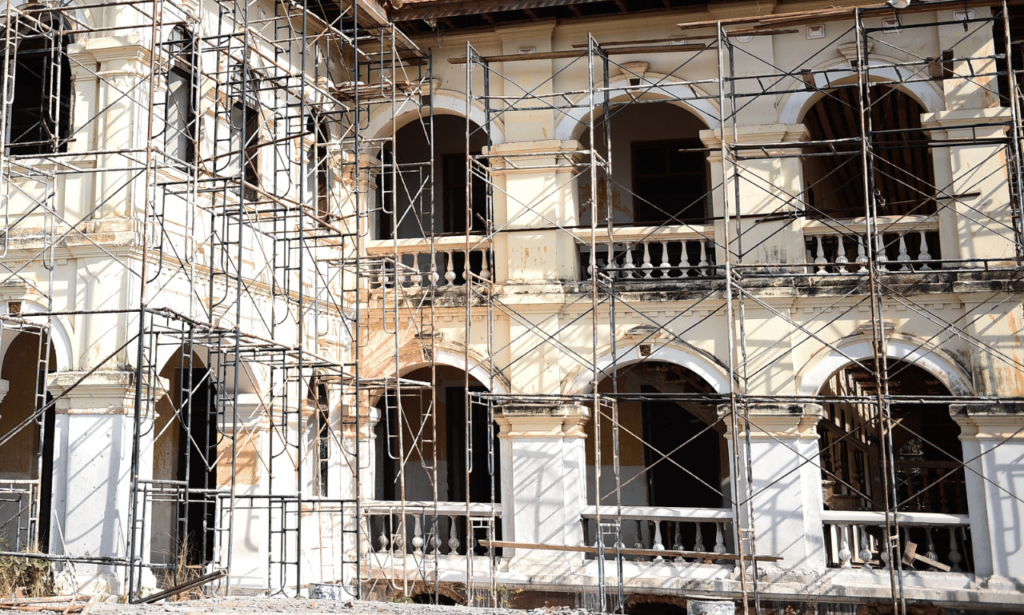
Proper setup of scaffolding is crucial to ensure a safe and stable working platform for construction projects. It involves a series of well-defined steps that should be followed diligently. Here is a step-by-step guide to scaffold assembly:
- Base setup: Begin by laying out the base of the scaffold. Place base plates or adjustable screw jacks on a sturdy surface to provide a stable foundation. Make sure the base plates are level and properly aligned.
- Connecting horizontal poles: Connect horizontal poles using metal braces and secure them with bolts. Ensure that the poles are aligned accurately to maintain structural integrity.
- Positioning vertical poles: Position vertical poles at regular intervals along the base. These poles serve as the main support structure for the scaffold. Connect them with the horizontal poles using bolts and tighten them securely.
- Adding diagonal braces: Diagonal braces play a vital role in reinforcing the scaffold structure. Install diagonal braces between the vertical and horizontal poles to enhance stability and prevent swaying. Secure them properly using bolts.
- Platform installation: Place platforms on top of the vertical poles to create a working surface for construction activities. Ensure that platforms are level, secure, and properly attached to the scaffold structure using brackets.
- Access ladder: Install an access ladder or staircase to provide safe and convenient movement on the scaffold. The ladder should be securely attached and positioned to allow easy ascent and descent.
Following these steps systematically will result in a well-constructed scaffold that meets safety standards and provides a reliable working platform for construction teams.
Scaffold Assembly Process
Now that we have covered the steps for setting up scaffolding, let’s take a closer look at each stage of the assembly process:
| Step | Description |
|---|---|
| 1 | Lay out the base using base plates or screw jacks and ensure level alignment. |
| 2 | Connect horizontal poles with metal braces and secure them with bolts. |
| 3 | Position vertical poles at regular intervals and connect them with bolts. |
| 4 | Add diagonal braces between the vertical and horizontal poles for added stability. |
| 5 | Place platforms on top of the vertical poles and secure them with brackets. |
| 6 | Install an access ladder for easy movement on the scaffold. |
By carefully following these steps, you can ensure a well-assembled scaffold that provides a secure and efficient working environment for construction projects.
Key Considerations for Scaffold Setup
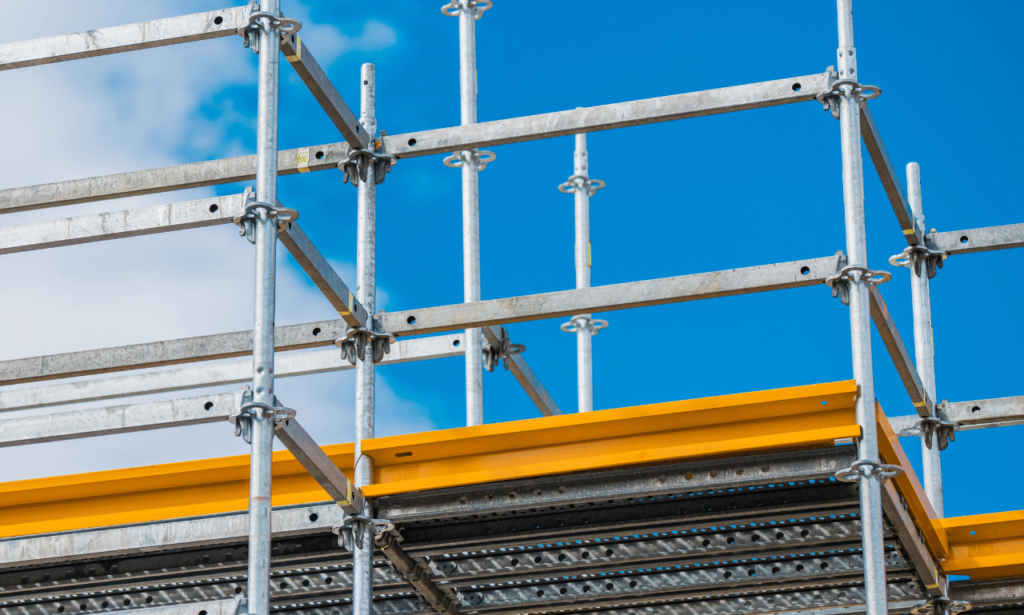
When setting up scaffolding, there are several key considerations that should not be overlooked. By keeping these factors in mind, you can ensure a safe and secure scaffold setup.
Two-Person Setup
A two-person setup is highly recommended for scaffold assembly. With one person responsible for positioning and leveling the base plates, and the other hammering in the ground anchors, the setup process becomes more efficient and reduces the risk of errors.
Base Plate and Caster Installation
Proper installation of base plates and casters is crucial for the stability and mobility of the scaffold. Base plates should be securely fastened to a stable surface using mudsills or jackscrews. This ensures a solid foundation for the scaffold. Casters should be installed on the scaffold legs, allowing for easy movement and repositioning when needed.
Level and Balance
Ensuring that the scaffold is level and balanced is essential for the safety of workers. Use a level during the setup process to check if the scaffold is straight and even. Adjust the base plates and legs as necessary to achieve the desired levelness and balance.
Secure Fastening
Every component of the scaffold should be securely fastened to prevent any dislodgment or collapse. Double-check and tighten all bolts, nuts, and connectors to ensure a solid connection. This includes securing the platforms, cross braces, and guardrails firmly in place.
Guardrails and Toeboards
Installing guardrails and toeboards is essential for the safety of workers on the scaffold. Guardrails provide a protective barrier to prevent falls, while toeboards prevent tools and materials from slipping off the platform. Make sure these safety features are properly installed and meet the required height and strength specifications.
Regular Inspection
Regularly inspecting the scaffold is critical to ensure its stability and safety. Check for any signs of damage, such as corrosion or loose components, and address them immediately. Perform routine inspections before each use and document the findings to maintain a safe working environment.
By considering these factors during scaffold setup, you can create a secure and reliable working platform for your construction projects.
Safety Guidelines and Inspection
Safety is of utmost importance when working with scaffolding. To ensure the well-being of workers and prevent accidents, it is crucial to follow proper safety guidelines and conduct regular inspections.
Personal Protective Equipment
When working on scaffolds, it is essential for workers to wear the appropriate personal protective equipment (PPE). This includes **hard hats**, **safety harnesses**, and **non-slip footwear**. Hard hats protect against falling objects, while safety harnesses prevent falls from heights. Non-slip footwear provides stability and prevents slips and trips.
Weight Capacity
Each scaffold has a specific weight capacity that must not be exceeded. It is important to carefully consider the weight of workers, tools, and materials that will be on the scaffold and ensure it remains within the weight limit. Overloading the scaffold can compromise its structural integrity and increase the risk of accidents.
Inspections
Regular inspections are crucial to ensure the stability and safety of scaffolding. Inspections should be performed before each use and should include checking for stability, loose or missing parts, and signs of corrosion. Any issues should be addressed immediately to prevent accidents or potential injuries.
To help facilitate inspections, it is recommended to use an inspection checklist. This checklist should include items such as checking guardrails, toeboards, and base plates for proper installation and security. It should also include a review of the overall structure, including all connections and joints.
Incorporating these safety guidelines and following inspection protocols not only ensures the well-being of workers but also helps maintain a safe work environment. By being proactive and diligent in safety practices, construction sites can minimize risks and promote a culture of safety.
Conclusion
Setting up staging scaffolding is crucial for construction and maintenance projects. It provides a secure and elevated platform for workers to access heights, ensuring their safety and improving the efficiency of the project. By following the proper setup guidelines, obtaining the necessary permits, and conducting regular inspections, scaffolding structures can be made safe and reliable.
Prioritizing safety is of utmost importance in any construction site. By adhering to safety regulations and using high-quality equipment, accidents can be prevented, and worker well-being can be maintained. Investing in the right scaffolding systems and ensuring their proper installation and maintenance is essential for the success of construction projects.
Efficiency is also enhanced through the use of staging scaffolding. With a secure and stable platform, workers can perform their tasks efficiently, saving time and increasing productivity. Scaffolding provides easy access to heights, ensuring that work can be completed without unnecessary delays or complications.
FAQ
What is staging scaffolding?
Staging scaffolding is a construction equipment that provides an elevated platform for workers to safely work at heights.
What are the different types of scaffolds?
The different types of scaffolds include frame scaffolds, suspended scaffolds, and cantilever scaffolds.
What permits and approvals are required for setting up scaffolding?
Before setting up scaffolding, it is important to obtain building permits, temporary construction permits, or inspection certificates.
How do I set up scaffolding?
The assembly process involves laying out the base, setting up vertical poles, adding diagonal braces, placing platforms, and attaching an access ladder.
What should I consider during scaffold setup?
During scaffold setup, it is important to have two people, securely fasten the base plates, install guardrails and toeboards, and ensure all components are securely fastened and levelled.
How do I ensure safety when working with scaffolding?
Safety can be ensured by wearing appropriate personal protective equipment, avoiding climbing or standing on guardrails, not exceeding weight capacity, and regularly inspecting the scaffold for stability and corrosion.
Why is staging scaffolding essential for construction and maintenance projects?
Staging scaffolding provides a secure platform for workers to access heights, ensuring safety and efficiency on job sites.


